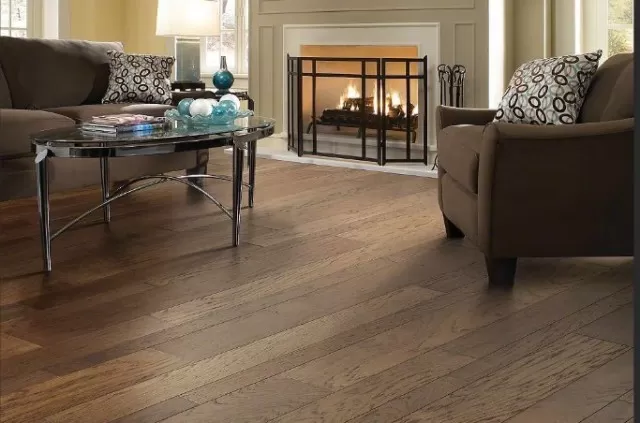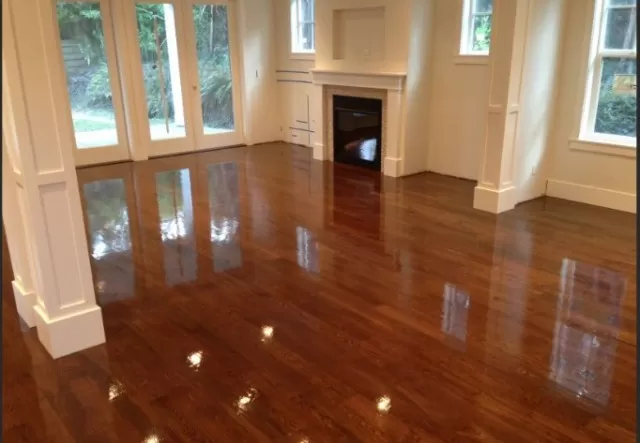Flooring Upgrade: 5 Top Hardwood Options to Consider. Consider your budget, aesthetic preferences, and the specific needs of each space when choosing a wood surface.
Keep in mind that different materials have varying levels of durability and maintenance requirements. Consult with flooring professionals or visit showrooms to see samples firsthand and gather expert advice. By carefully evaluating these factors, you can find a wood surface that combines the desired look, long-lasting wear, and affordability for your flooring project.
Comparing Solid and Engineered Hardwood Flooring: Cost, Versatility, and Considerations

When it comes to hardwood flooring options, two popular choices stand out: solid hardwood and engineered hardwood.
Solid hardwood floors are known for their authenticity, as they are crafted from a single piece of wood. On the other hand, engineered hardwood flooring provides a similar aesthetic appeal but with added advantages and a slightly more affordable price tag.
Solid hardwood flooring boasts the timeless beauty of natural wood, exhibiting its unique Grain Patterns and characteristics.
Each plank is milled from a single solid piece of wood, ensuring a durable and long-lasting floor. However, the cost of solid hardwood can be a significant factor to consider.
For instance, prefinished solid red oak flooring typically costs around $5 per square foot.
Engineered hardwood flooring, on the other hand, presents an attractive alternative with its enhanced versatility and cost-effectiveness.
Engineered boards consist of multiple layers, with a top layer made of real hardwood. This construction not only mimics the appearance of solid wood but also provides added stability and resistance to moisture.
Engineered red oak flooring is often priced $1 to $2 less per square foot than its solid counterpart, with the thickness of the hardwood layer affecting the overall cost.
While cost plays a role in decision-making, it is essential to weigh the benefits and drawbacks of both solid and engineered hardwood flooring options.
Solid hardwood flooring offers unparalleled authenticity and Durability but can be more susceptible to moisture-related issues. Engineered hardwood, with its layered construction, excels in resisting moisture and provides more installation options, such as basements and concrete slabs.
However, the longevity of the engineered floor may be influenced by the thickness of the hardwood layer and the quality of the underlying layers.
Ultimately, the choice between solid and engineered hardwood flooring depends on personal preferences, budget considerations, and the specific requirements of your living space.
By carefully evaluating the pros and cons of each option, you can make an informed decision that enhances both the aesthetics and functionality of your home.
The Ins and Outs of Hardwood Flooring Finishes

When it comes to hardwood flooring, the finishing process plays a crucial role in both the aesthetics and durability of the floor.
In the past, solid hardwood floors were typically installed unfinished, requiring additional steps of staining and applying a protective finish coat. However, today’s market offers the convenience of prefinished hardwood flooring, which comes with the stain and topcoat already applied.
Let’s explore the key aspects and considerations of both unfinished and prefinished hardwood flooring.
Unfinished hardwood flooring provides a few distinct advantages.
Firstly, it offers the smoothest surface as it is installed and then sanded, eliminating any height discrepancies between the boards. Additionally, unfinished flooring allows for custom colors, giving you the opportunity to create a unique shade by having the stain custom-mixed at a paint store.
However, the installation process for unfinished hardwood is more time-consuming, often taking three or more days to complete since it involves multiple phases of installation, sanding, staining, and finishing. Moreover, sanding the entire floor can generate a significant amount of dust, and some stain and finish products may emit unpleasant fumes during application, necessitating proper ventilation.
On the cost front, unfinished hardwood flooring tends to have lower material costs compared to prefinished options.
On average, it can be about $1 per square foot less expensive. For example, unfinished Red Oak flooring may cost around $4 per square foot, while prefinished Red Oak can be priced at approximately $5 per square foot.
However, the labor required to stain and finish the floor adds to the installation costs, making unfinished hardwood more expensive when professionally installed. Depending on labor costs in your area, it’s possible that hiring a flooring professional to install and finish the floor may cost more than having a prefinished floor installed.
Additionally, if you choose to install the floor yourself, you won’t have any recourse if the finish doesn’t hold up to normal wear and tear.
In contrast, prefinished hardwood flooring offers a range of benefits.
It comes in a variety of colors, typically a few dozen options, although customization is not possible. Prefinished flooring often has higher initial material costs but lower installation costs compared to unfinished hardwood.
Since no staining or finishing is required during installation, a professionally installed prefinished hardwood floor is often more cost-effective in the long run. Furthermore, the prefinished option eliminates exposure to dust and toxic fumes associated with sanding and finishing.
Manufacturers usually provide warranties for prefinished hardwood floors, protecting against defects in stain and finish coat.
To make an informed decision about your hardwood flooring, it is advisable to consult with a flooring expert.
These professionals can provide valuable guidance, assess your specific needs and preferences, and offer free estimates for your project. By seeking expert advice, you can ensure that your hardwood flooring choice aligns with your budget, desired aesthetics, and functional requirements, ultimately leading to a successful and satisfying installation.
Exploring Hardwood Species: Colors, Grain Patterns, and Durability

When it comes to choosing the right hardwood flooring for your space, considering the species of wood is essential.
Different hardwood species offer distinct colors, grain patterns, and levels of durability. One way to gauge a wood’s hardness and durability is by referring to the Janka Hardness Scale, developed by Gabriel Janka in 1906.
This scale has become the industry standard for measuring wood hardness, with higher rating numbers indicating harder and more durable wood. Let’s delve into some popular hardwood species and their characteristics:.
Oak: Oak is a highly popular hardwood for flooring, and it comes in two primary types—red oak and white oak.
Red oak, with a Janka rating of 1290, is a versatile choice that suits various flooring needs. It features warm tones ranging from creamy pink and golden red to rusty brown, along with graceful swirled grain patterns.
Red oak complements a range of décor styles. On the other hand, white oak, with a Janka rating of 1360, is slightly harder than red oak and is often chosen for high-traffic areas.
It has gray undertones, no red hues, and a consistent grain pattern that exudes elegance.
Cherry: Known for its warm brown hues and smooth grain pattern, cherry is a slightly softer hardwood, ranking at 950 on the Janka scale.
It is best suited for lower-traffic areas like bedrooms and formal dining rooms. Over time, cherry wood has a tendency to darken, particularly when exposed to sunlight.
To enhance its visual impact, wider planks—up to 8 inches—can be installed to showcase the beautiful grain pattern of this wood.
Walnut: Walnut offers deep, rich chocolate tones and prominent straight grain patterns, making it a popular choice for those seeking drama and sophistication.
With a Janka rating of 1010, walnut is suitable for medium-to-light traffic areas, although it may show signs of wear in high-traffic zones over time. Walnut floors exhibit minimal color variation from board to board, resulting in a smooth and consistent appearance.
Hickory: Hickory is a highly durable hardwood with a Janka rating of 1820, making it an excellent choice for high-traffic areas.
In the past, it was even a preferred option for school gymnasium floors. Hickory features mocha-tones, ranging from creamy beige with a hint of red to warm brown with dark brown streaks.
The wood has large knots and substantial color variation from board to board, making it particularly well-suited to rustic and country-style interiors.
Maple: Maple is another durable hardwood, ranking at 1450 on the Janka scale, and it is suitable for most rooms.
It exhibits a fairly light color palette, including shades of light cream, beige, and tan, often with a slight reddish tint. Maple has a fine grain pattern, occasionally accented by dark streaks and specks, adding visual interest to the wood.
This versatile hardwood complements a variety of styles, including contemporary, transitional, and eclectic designs.
In the process of choosing the right hardwood species, consulting with a flooring expert can provide valuable insights.
Licensed flooring professionals can offer guidance specific to your needs, recommend suitable species based on your preferences and the intended use of the space, and provide free estimates for your project. By leveraging their expertise, you can ensure that your hardwood flooring selection aligns with your desired aesthetic, functional requirements, and long-term durability.
*The information is for reference only.